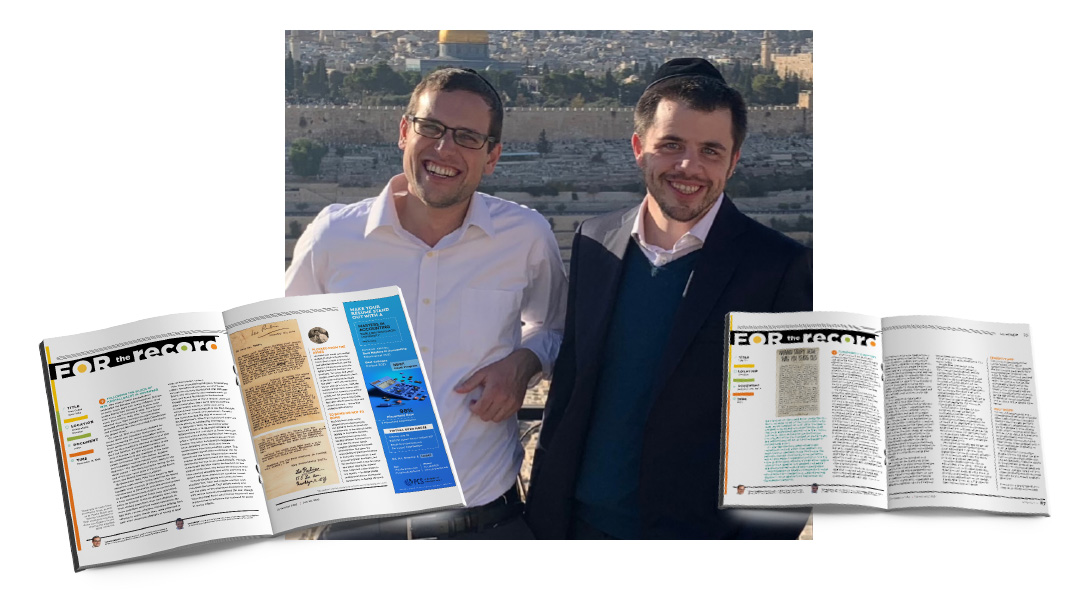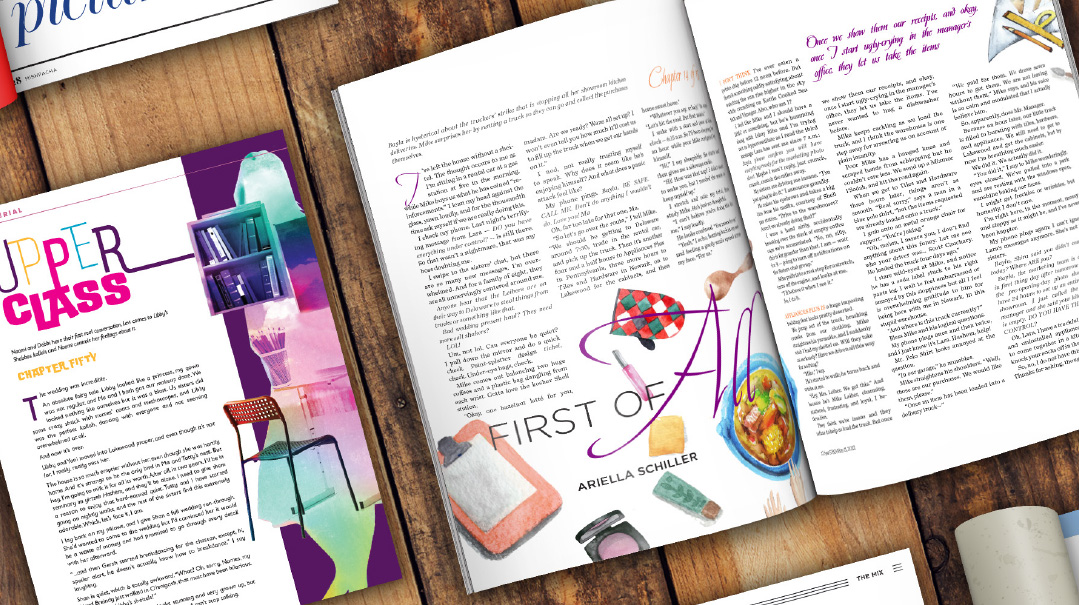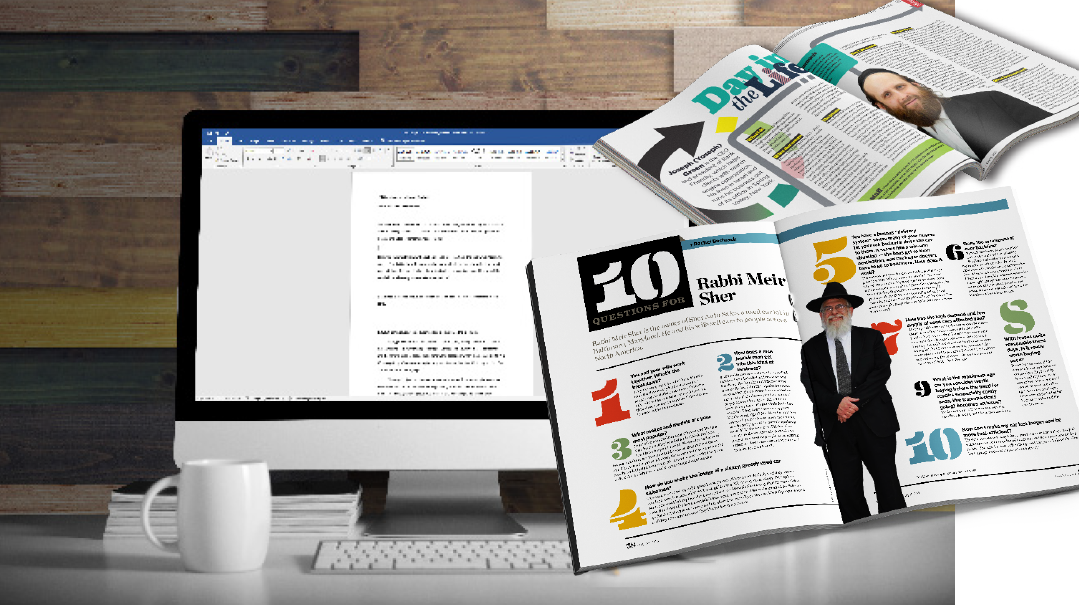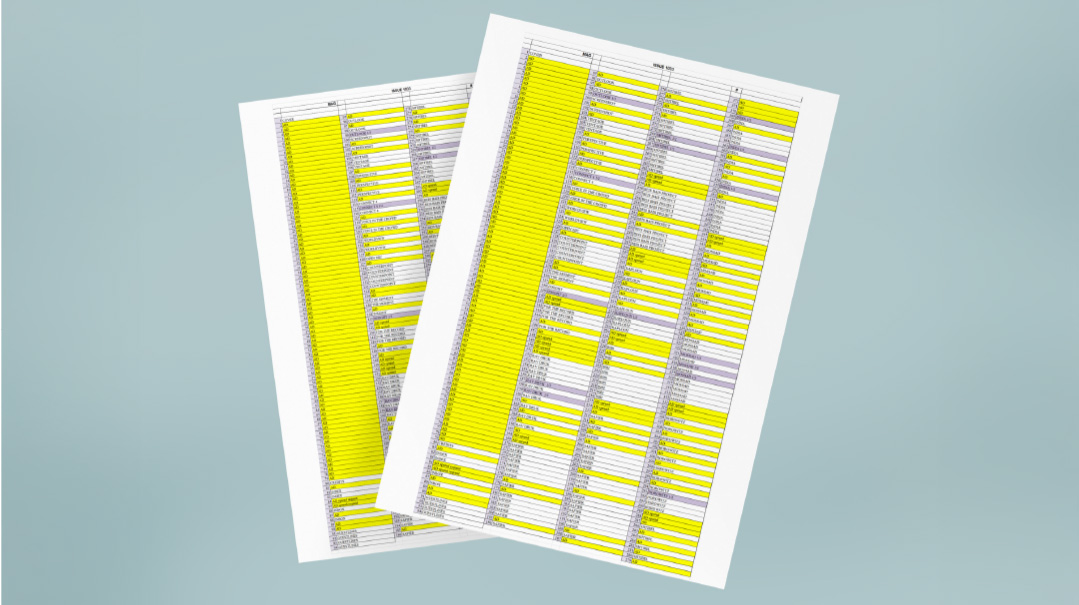20 Questions for Avi Lazar
| September 24, 2024“If you want to be successful in any role, you need to learn the business you’re in from the ground up”

Avi Lazar has been the CEO of Mishpacha USA since 2009. Based in Mishpacha’s US offices, he carries the responsibility for advertising sales, finance, marketing, and US distribution, coordinating a labyrinth of logistics to deliver the weekly magazine to your doorstep come rain, shine, or tight Yom Tov deadline.
My ideal work environment
is a sterile desk
Deadlines make me
excited, as I anticipate crossing something off my list
The best piece of business advice I got was
at my first job in health and beauty aids, where I was hired to an executive position. On my first day, I was handed a broom and told to sweep the warehouse floor. If you want to be successful in any role, you need to learn the business you’re in from the ground up and experience what it’s like to perform all tasks, so you know what you’re asking of your employees.
1
Which responsibilities rest on you?
Our team is primarily responsible for the revenue-producing portion of the company. We have three main revenue streams: store sales, subscriptions, and of course, advertising, and we’re responsible for all of them. My other responsibilities include North American distribution, planning and creating local and national events, branding/marketing, and public relations. We also produce some content, as we handle the Family Table section as well as liaise with editors on leads we bring in.
I work primarily with our administrative staff to plan and execute the running of the company. Other teams I work closely with include our finance, advertising, subscription, and business development departments. I also interact with our printer, third party delivery services, and other vendors.
2
Mishpacha has offices in America and Israel and a staff that spans the globe. What is the biggest challenge in operating an international company?
In a previous life, I was president of the wholesale department at IDT and communicated with managers in Hong Kong, South Africa, Argentina, and all of Europe, which prepared me well for operating within a multicountry company. There’s the time difference, naturally, and the physical distance of teams under multiple roofs presents challenges. It’s a high priority to foster a great work environment between our teams. However, there are also benefits. For example, when everyone else in the world was figuring out how to operate remotely during Covid, we had few transition problems — we’re used to that setup! Also, since our Israel team works Sundays while our US team works Fridays, our company operates on a six-day work week and 15-hour days (instead of eight).
There is a language barrier, but it’s not too difficult — I understand and speak Hebrew well enough to get by (and when in doubt I’ll just use the English word with a slight accent, and they react as if it’s actually their own Hebrew word!). But for the most part, almost everyone speaks both languages, and we use a little bit of Google Translate in between.
3
What is the biggest change you’ve seen in the market since you started?
When Mishpacha launched as a glossy weekly, it was the only product of its kind on the frum English-language market, and how much that has changed is obvious. Competition brings out the best in us, and despite many other products available now, we continue to grow, a true testament to our editorial team and the depth of the market. Since we launched, the frum media market and frum marketing in general has completely exploded. Digital content and marketing, which used to be fringe sectors, are now quite strong; social media didn’t exist; and most people had no access to the internet unless they were at a desktop. Attention spans have shortened significantly. What kinds of stories we consider cutting edge, and what we consider entertainment altogether, has completely changed. In fact, our archives read like a time capsule, and sometimes I like to look back on our earlier issues, just to remind myself.
4
What happens to the magazine after it gets sent to print and before it reaches the readers?
After we send the magazine files to print, our printer sets up every page and does what’s called “preflighting,” where they check for bleed, color settings, and image resolution. Then they print it all, bundle the pieces together, and polybag (i.e., shrink-wrap) it into the package you get every week. Most magazines are trucked to a local Queens warehouse. Most subscriber magazines are sent to local depots for home delivery, while others are mailed via air or private carrier services all around the country.
Our local distributor — the Zupnicks who run The Weekly Publications delivery service — drop off magazine bundles at the local stores. We try to make these deliveries at night in order to save hours working through rush- hour traffic, and we try to get our out-of-town shipments to the airports early enough that our cargo is loaded right after the fresh fish shipments, which get precedence due to the spoilage factor.
5
Where is Mishpacha distributed?
Well, Mishpacha is a global magazine. We’re currently available in four continents — we even dabbled in a Spanish edition down in South America for a while! Anywhere there’s a concentration of English-speaking Yidden, there’s Mishpacha. But beyond that, Mishpacha is accessible in far-flung places — like the reader from Vancouver who used to drive down to Seattle each week (I googled it for you — two-and-a-half hours!) to pick up her weekly dose of Mishpacha. We also have a Braille edition that gets distributed via our friend Reb Nachman Lehman of CSB Care, making Mishpacha available to the vision-impaired.
6
What happens if Mishpacha is not sold in my area?
We have dozens of groups of subscribers that we’ve formed around the United States who receive a direct shipment of the magazine weekly. It’s pretty simple, anyone can start a new group if there are ten or more interested subscribers, and we do this in places in the Tristate area with fewer grocery stores, like Deal, New Jersey, and Waterbury, Connecticut, as well as groups that are further from the East Coast, like Scottsdale, Arizona; St. Louis, Missouri; and many, many more. For even less populated areas (or for those who just prefer it), we have a direct mail option, and we mail magazines to pretty remote locations, as far as Palo Alto, California, Torrington, Wyoming, and Oswego, Oregon. For some individuals who find themselves in inpatient facilities, rehab, or jails, their weekly Mishpacha delivery is their link to the Jewish world.
7
What is something that most readers wouldn’t notice that makes a big difference on the logistics end?
Our printing deadline. When a major news event breaks close to the deadline — stam election results, which we know about in advance but don’t know the outcome, or an assassination attempt on a presidential hopeful, or a president pulling out of the race a little over 100 days before the election, or a tragedy, Rachmanah litzlan — this creates a dilemma for us: do we delay printing and risk readers not receiving their magazines in time for Shabbos, or do we wait until we can cover something properly the following week? Our readers expect to read the latest news and to get it before Shabbos, so we do everything we can to make both happen. It does require jumping through hoops, like our editorial teams working through the night, trying to find a new printing slot that will allow us to still get to newsstand on time, rescheduling cargo flights, taking extra workers on trucks when delivering during the day and we can’t stop in the middle of a Boro Park street — basically calling in any and all favors that we can. Fortunately, by now our team is equipped to react quickly to these time-sensitive situations. Of course, sometimes major news breaks right after we’ve printed, and then we have no choice but to wait for the following issue — but we know readers are disappointed it isn’t in that week.
8
What efficiencies have you developed over the years to streamline operations?
Believe it or not, when Mishpacha’s English edition started back in 2004, it was flown from Israel to the US every week. Today, we print in three locations: the US, Israel, and Europe, and we ship from those locations. Our team focuses on the North American division. Working with a printer and distribution team that we trust is a big brachah, because it helps keep things efficient.
We’ve also learned to ask the right questions. For example, once we had a truck scheduled to deliver magazines to our warehouses for dissemination to the distributors. It was supposed to be delivered at 11 p.m., but it didn’t show, and meanwhile our staff was waiting to start their distribution to stores. Distribution goes through the night, it’s on a tight schedule — but there was radio silence from the trucker. As it turns out, truckers cannot drive for more than an allotted number of hours per day, and he had taken the job without enough time left in his day to complete it, so he drove the full truck home to go to sleep with plans to deliver it the next day. Lesson learned! These days, before we hire any new carrier or driver we explain that same-day delivery is non-negotiable.
That’s at the printing end. We’ve also done things for subscribers like developing fully automated options for those who find it inconvenient to call to manage their subscriptions; we have a text-in option and an online portal on our website.
9
Are there special processes and considerations when planning a Yom Tov package or a special issue?
Yom Tov planning starts weeks in advance, and considerations include: what day does Yom Tov fall out, and how many days will the Yom Tov package be available on newsstands? Do we ship the extra-heavy Yom Tov magazines via air or is there time for trucking? How many people will be traveling to Eretz Yisrael, or to Orlando, and can we estimate based on the calendar when they will travel?
10
What was the most memorable unexpected technical challenge you’ve dealt with in your time at Mishpacha?
Years ago, when we were still flying shipments from Israel to Europe, we had a delay due to the eruption of a volcano in Iceland that was impacting flight patterns — that was not your everyday issue. More recently, we had a high-stakes chase of an entire store’s shipment that had been stolen by a group of vigilantes. Utilizing the security footage, we were able to do some investigative work to identify the people and vehicles involved. It involved sh’eilos to gedolim and involvement from local dayanim and the police, but we recovered the magazines in the end, and we figured we can always save the details for a cops-and-robbers style Treeo comic one day!
11
Can you tell us about a time you had to do damage control?
Someone once called, after the last magazine had finished printing, to say that an ad had included a photo of their family member without their consent. In the end, the person was so adamant that he agreed to cover the entire additional cost to reprint, and we made it happen with minimal delay in delivery.
12
Who have you met in your capacity as CEO that made a lasting impression?
We do not take for granted the great responsibility that we hold as a public-facing media company; it’s something that weighs on our editorial department deeply. That’s the lens through which we look at the content and ads, and to ensure we stay on track, we make it a priority to have our editorial and executive staff meet regularly with gedolei Yisrael. Time and time again, I’ve been fortunate to see their brilliance, clarity, and ability to have their finger on the pulse of the klal firsthand. From directing our staff on which social issues to highlight, or how content can or can’t be included, even sometimes down to the sensitivity of the way things are worded. We also have the zechus to work with many special individuals that are osek b’tzarchei tzibbur, some whose names you all know and some who are very behind the scenes. There are a million opportunities in this job to say “Mi k’amcha Yisrael.”
13
Which part of Mishpacha gives you the most nachas?
Being part of a company that employs and provides parnassah to so many families across the globe is really meaningful. And promoting from within is a particular nachas. A number of people have come to Mishpacha with raw skills and have successfully navigated their way up the ladder. That starts from the top — our publisher Eli Paley always likes to mention how he started as a delivery person and worked his way up until he eventually purchased the business. Another good example would be Chanie Nayman, who was hired as an administrative assistant doing some graphics for us as well, and she moved around and up until becoming the editor of Family Table. There are many, many more examples within the company.
I also find myself blown away, even after all these years, by how much Mishpacha is a conversation starter across the globe. It’s a real achrayus that we take very seriously, because we know full well what impact irresponsible media can have on the public. To that end, we make sure our staff consists of erlich people who take that responsibility seriously and stay on track. I’m also proud that all our decisions are made through daas Torah. We can have an opinion, but at the end of the day, the rav’s decision is always the final word.
14
What is the complaint you get most often about something that’s totally not in your purview?
Feedback about content. The business office operates independently from our editorial office, so our US customer service team sees the magazine at the same time it hits the newsstands. They get all sorts of questions, complaints, and inquiries about content that they have no say in or prior knowledge of.
15
What is the most heartwarming feedback you ever got?
There have been calls where an article led someone to a long-lost friend or family member, or people who were inspired by a story, or helped someone in some meaningful way, or make a shidduch. We really love that kind of feedback, that’s a fun part of the job!
16
When do you see the lasting impact of your work at Mishpacha?
One of the things that has struck me over the years is how many conversations about serious topics have been started in the magazine and then migrate to “real life.” I’ve been to (or sent clips of) countless speeches by rabbanim who reference topics we just covered extensively in the magazine. Years ago, with the careful direction of gedolim, we opened the discussion about abuse in the frum community, and there was a huge amount of criticism from our conservative audience who felt it was a breach of tzniyus. There was so much pushback that a large grocery store in a frum community refused to sell the magazines for a while! Lo and behold, this became the theme of that year’s Agudah Convention, and hopefully has helped many people since.
17
How has the marketing of the magazine changed over the years?
It’s gotten much more sophisticated. We used to advertise only in our own magazine and offer gifts such as cookbooks for new subscribers. These days, people are exposed to so many marketing messages, so getting our message across has to be more multifaceted, and in addition to our own print ads, we’re producing commercials (to be shown during nonprofit videos we sponsor, for example) and WhatsApp statuses, advertising on third-party platforms, and occasionally putting up billboards and outdoor ads.
18
How do you market a medium which is a marketing tool in and of itself?
Mishpacha is more than the magazine — it’s a brand — and there are always opportunities to market that brand. We like to have a mix of overt marketing, like the branding ads you’ll see in the pages of the magazines, as well as other creative solutions that expand our horizons. For example, our extremely wide content library allowed us to help launch the popular lifestyle and recipe website Kosher.com, which, eight years later, is a partnership we all cherish. That’s us using our content in a way that helps our brand reach an expanded digital market.
19
What makes an event a fit for Mishpacha, a print magazine?
Events are a great way to personalize the magazine, to allow readers to meet the names they’ve seen so many times on our pages with an added experiential component. A crucial part of the job of CEO is to consider all ideas and opportunities that get pitched and see what we think will enhance the overall brand and connection to our readers. We’ve done things that are a clear extension of the print brand, like Family Table classes, demos, and meet-and-greets all over the US, events that educate and entertain our audience (much the way a great feature article would), like our nonprofit events. We run a live Kichels game show, which is very popular in schools and camps, and we once did a summit, where we gave the movers and shakers of the frum world an opportunity to meet and speak to our editors and writers face-to-face.
20
What was the craziest story your team has had with a marketing project?
We’ve done some fun things, and the best projects are ones the team is excited to produce — you feel it in the end result, even if things don’t go according to plan. I remember last year, when we rebranded our kids’ magazine Mishpacha Jr. and relaunched it as Treeo, we planned to have human-sized Squizzles (Treeo’s adorable squirrel mascot) on location in a few grocery stores in Lakewood giving out prizes and posing for photos. We ordered custom mascot suits for the events months in advance, but as the launch date loomed, our overseas order was just not showing up. Plan B was to find a generic squirrel mascot costume and use that with custom Treeo swag. There were only two such costumes available in the Tristate area that would get to us in time, and we ended up using those.
PS: The custom Squizzle costume finally made its way past customs three days after the launch event. So far, it just serves to entertain the kids that come into our Five Towns office when school is out and their parents have to work.
(Originally featured in Mishpacha, Issue 1030)
Oops! We could not locate your form.







